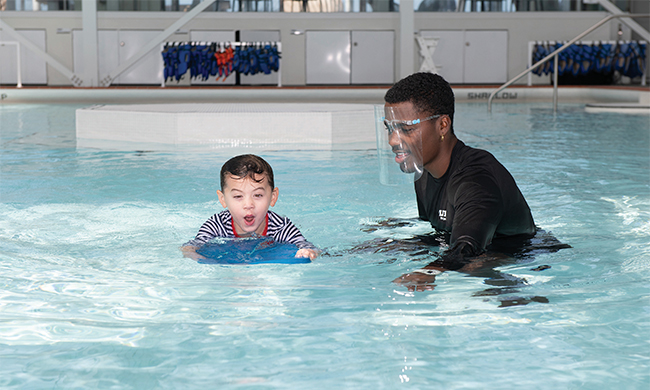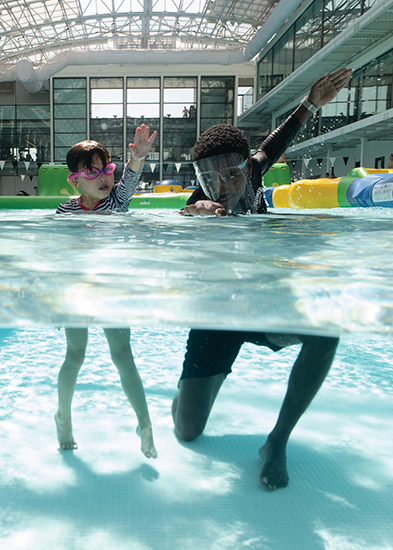Live Better
Wave of fun: Swimming safety tips for summer


Swimming safety tips for summer
(Family Features) Playing in or around water is one of the joys of summer, but this treasured seasonal pastime comes with some serious risks. Drowning is the second-leading cause of accidental death for children under the age of 14 in the United States, according to the Centers for Disease Control and Prevention.
As COVID-19 restrictions ease, many families will have more informal gatherings and take trips to the beach, increasing the potential for children to have unsupervised access to water sources. Because of this, it’s important for children to take swimming lessons to learn water safety skills and create safer habits in and around water. As swimming lessons begin across the country, many are being conducted safely with COVID-19 precautions in place.
Protect your family’s safety around water this summer with these tips from the Make a Splash Tour, presented by Phillips 66 and the USA Swimming Foundation.
Designate a Water Watcher and Closely Monitor Children. Designate a water watcher when you are in, on or around water. Watch all children and adolescents swimming or playing in or around water, even if they know how to swim. Keeping young children or inexperienced swimmers within arm’s length at all times can help ensure you’re able to provide assistance if and when it’s needed.
Wear a Life Jacket. Anyone participating in any boating, paddling or towed water sports, regardless of swimming ability in pool or open water situations, should wear a Coast Guard-approved life jacket. Preschool-aged children (5 years old and younger), who are not protected by touch supervision, in particular, should always wear a life jacket. Swimming aids and water toys – such as water wings, inflatable water wings and rings – are not intended to be life-saving devices. They may provide some buoyancy in the water but do not prevent drowning.
Swim with a Buddy. When possible, choose swimming locations where a trained lifeguard is watching for dangerous conditions and helping keep an eye on swimmers. Also make it a practice to always have at least two people swimming together. That way, if someone has a problem, the other can get help.
Learn to Swim. Research has shown formal swimming lessons reduce the risk of childhood drowning by 88%. Through the annual Make a Splash Tour, the USA Swimming Foundation, with the support of Phillips 66, encourages children’s swim lessons. By equipping your child with the skill of swimming, you’ll open doors to a lifetime of safety, fun, fitness and even employment opportunities.
While lessons progressively teach a variety of swimming strokes, some of the most important things swimmers learn – even in beginner classes – are breath control and how to float. These basic skills are essential for staying above water should someone find himself or herself unable to touch or too tired to swim to safety. Children can participate in swimming lessons before they can walk, and parent-child swim lessons provide bonding opportunities along with water safety education.
Enter Water Feet First. Diving in a pool that is too shallow or into water where you’re not certain what’s below the surface, like a lake, can have dire consequences. Teach children to dive only in designated diving areas and to always enter water of unknown or non-visible depth feet first.
Swim in Designated Areas and Obey Posted Signs and Flags. Ropes, buoys and flags in larger bodies of water like lakes or oceans are commonly used to mark off safe swimming areas and provide visual cues about changes in depth, underwater surfaces and currents. Teach children what these signs and markers mean and that they’re in place as safety tools, not toys to play with or float on.
Learn CPR. If the unthinkable does happen, knowing how to perform CPR allows you to take immediate action, which has been shown to significantly better the outcome for children with submersion injuries. In the time it takes for paramedics to arrive, you could save someone’s life. Seconds count; the more quickly lifesaving CPR is started, the better the chances of recovery. There are many places that offer CPR training, including community organizations and nonprofit groups. Remember to keep your certification current once you have completed the initial requirements.

Finding a Swim Lesson Provider
If you’re unsure where to take your child for swim lessons in your community, these tips can help:
- Ask other parents in your area where they take their children. You can ask people you know and use social media and neighborhood boards to get tips. If your school has a swimming team, the coach may also be able to give you some ideas.
- Another resource is online search tools, such as usaswimming.org/makeasplash, which allows you to search for swim lesson providers near you. Many of these programs also offer options for free or reduced-cost swim lessons.
- Once you identify a program, visit the facility with your child to see how swim lessons are run.
- Find out who your child’s teacher will be and whether it’s possible to meet him or her in advance.
- Learn the program expectations for you as a parent or guardian.
- Inquire about the provider’s approach and learn-to-swim philosophy.
While researching programs, some industry best practices to look for include:
- Ask about the facility’s COVID-19 mitigation protocols. Swim lessons can be safely administered with proper protective equipment and procedures.
- A nationally recognized learn-to-swim curriculum or an independently developed learn-to-swim curriculum that follows a similar model.
- Trained and certified instructors, with on-deck lifeguards holding current CPR and first aid certifications.
- A maximum 6-to-1 student-to-instructor ratio for group lessons.
- Minimum of 30 minutes per week of in-water instruction with a minimum total in-water instruction time of four hours.
- Written and practiced emergency action plans.
- Regulation of the facility and water by the Department of Health or similar governing agency.
- Established and practiced child-protection policies.
- Screening and background checks on all staff members.
Make safety a priority for your summer water fun. Find more information, including swim lesson providers in your area, by visiting usaswimming.org/makeasplash.
Live Better
Physical movement can help fight chronic diseases

Physical activity is a valuable tool in the fight against chronic disease and other conditions. In fact, the Cleveland Clinic highlights physical activity among its nine ways to prevent disease in an effort to live a long and rewarding life.
Children, adolescents, young adults, and even men and women in middle age may not face too many physical hurdles when they try to exercise, but seniors are not always so lucky. Aging men and women with mobility issues may wonder if they can reap the rewards of physical activity, and thankfully there are many ways to exercise even if getting up and going isn’t as easy as it might have been in years past. Sometimes referred to as “aerobic exercise” or simply “cardio,” cardiovascular exercise is an umbrella term that encompasses a wide range of physical activities that raise the heart rate and improve endurance. Seniors with mobility issues can look to various forms of cardio for inspiration as they seek to be more physically active without compromising their overall health.
· Walk your way to a healthier you. Walking is a form of cardiovascular exercise that is ideal for older adults with mobility issues because it need not be physically demanding and it’s safe to walk just about anywhere. Walking in a place such as a local park can be particularly good for older adults because they can take periodic breaks on benches if aches, pains or stiffness is affecting their ability to keep moving.
· Take up swimming. Swimming might be tailor-made for seniors with mobility issues because it’s a great workout and exercising in water tends to be less taxing on muscles and joints. The Cleveland Clinic notes that swimming promotes heart health, strengthens the lungs, helps to burn calories, and builds muscle, among other benefits. And many seniors find swimming is just as fun in their golden years as it was in their youth, which means aging adults might not face problems with motivation when the time comes to get in the pool.
· Use an exercise bike or portable pedal exerciser. Cycling is a wonderful exercise but one that seniors with mobility issues may feel is no longer possible. If doctors advise against riding a traditional bike, an exercise bike or portable pedal exerciser can provide many of the benefits of cycling without as great a risk for accident or injury. A portable pedal exerciser can be carried to a park, where seniors can still spend time in the great outdoors, which is one of the most appealing reasons to get on a bike and go.
· Take beginner yoga or tai chi. HelpGuide.org notes that gentle yoga or tai chi can help to improve flexibility and reduce stress and anxiety. Though yoga and tai chi can provide as much demanding physical activity as individuals allow, beginner classes in each discipline don’t require much movement but do provide enough for seniors hoping to be less sedentary.
Even seniors with mobility issues can find safe and effective ways to be more physically active. Prior to beginning a new exercise regimen, seniors with mobility issues are urged to discuss activities with their physicians.
Live Better
Connected communities: Reducing the impact of isolation in rural areas

(Family Features) Throughout history, humans’ ability to rely on one another has been crucial to survival. Despite modern developments that help individuals live with minimal human engagement, the human need to connect remains.
However, in many parts of America, a trend toward isolation is emerging. Over the past two decades, people are spending more time alone and less time engaging with others in person, according to data from the Office of the U.S. Surgeon General. One segment of Americans at particular risk of social isolation, loneliness and their negative impacts are select populations who live in rural areas.
“There is an urgent need to take action and improve mental health in rural America,” said Jeff Winton, dairy farmer and founder and chairman of Rural Minds, a nonprofit mental health advocacy organization that partnered with Pfizer to raise awareness about the physical and mental risks of social isolation. “Challenges to mental health can be inherent in a rural lifestyle, including a belief in self-reliance as a virtue, fear of judgment and difficulty getting an appointment with a limited number of mental health professionals, among others.”
Many Americans are increasingly spending more time alone according to the American Time Use Survey. They are increasingly more likely to take meetings, shop, eat and enjoy entertainment at home, making it easier for them to stay within their own four walls and avoid social interactions.
Authentic human connection is a basic but often unacknowledged necessity for health, “as essential to survival as food, water and shelter,” according to the U.S. Surgeon General’s Advisory on the Health Effects of Social Connection and Community.
Understanding Social Isolation
According to the Centers for Disease Control and Prevention (CDC), about one-third of U.S. adults reported feeling lonely and about one-fourth said they don’t have social and emotional support (the basis of social isolation).
The concepts of social isolation and loneliness can go hand-in-hand, but the two are actually quite different.
Social isolation is defined by an absence of relationships or contact with others. Someone experiencing loneliness may or may not have social connections, but lacks feelings of closeness, support or belonging. Despite the distinction, both can have a negative impact on a person’s mental and even physical health.
Several factors can influence a person’s risk for social isolation and loneliness.
“Social connection is a dynamic that changes over time,” said Nikki Shaffer, senior director, occupational health and wellness, Pfizer. “Transient feelings of loneliness or solitude may be beneficial because they can serve as motivation to reconnect. However, chronic loneliness (even if someone is not isolated) and isolation (even if someone is not lonely) can represent significant health concerns.”

Isolation in Rural America
Compared to people who live in urban areas, many rural Americans experience higher rates of depression and suicide but are less likely to access mental health care services, according to the “Health Disparities in Rural America: Current Challenges and Future Solutions” study published in “Clinical Advisor.” What’s more, CDC data shows suicide rates among people living in rural areas can be 64-68% higherthan those in large urban areas.
Rural areas have 20% fewer primary care providers compared to urban areas, according to a report in JAMA, and the Health Resources and Services Administration reports more than 25 million rural Americans, more than half of rural residents, live in mental health professional shortage areas.
Among rural counties, 65% lack a psychiatrist. Nearly 30% of rural Americans don’t have internet access in their homes, which complicates the option for telehealth. These figures from Rural Minds exemplify the challenges facing rural America.
“Some people in rural communities still don’t understand or accept that mental illness is a disease,” said Winton, who grew up on a rural farm. “Rather, a mental illness can often be viewed as a personal weakness or character flaw. A lot of the stigma around mental illness results in unwarranted shame, which adds to the burden for someone already suffering from mental illness.”
Health Impacts of Social Isolation
Loneliness is far more than just a bad feeling; it harms both individual and societal health. In fact, loneliness and social isolation can increase the risk for premature death by 26% and 29%, respectively.
Lacking social connection can increase the risk for premature death as much as smoking up to 15 cigarettes a day or drinking six alcoholic drinks daily.
In addition, poor or insufficient social connection is associated with increased risk of disease, including a 29% increased risk of heart disease and a 32% increased risk of stroke.
Social isolation is also associated with increased risk for anxiety, depression and dementia. Additionally, a lack of social connection may increase susceptibility to viruses and respiratory illness.
Learn more about the impact of social isolation, especially on residents of rural areas, and the steps you can take to reduce isolation and loneliness by visiting ruralminds.org.
Boost Your Social Connections
Take a proactive approach to combatting social isolation and loneliness with these everyday actions that can promote stronger social ties.
- Invest time in nurturing your relationships through consistent, frequent and high-quality engagement with others. Take time each day to reach out to a friend or family member.
- Minimize distractions during conversation to increase the quality of the time you spend with others. For instance, don’t check your phone during meals with friends, important conversations and family time.
- Seek out opportunities to serve and support others, either by helping your family, co-workers, friends or people in your community or by participating in community service.
- Be responsive, supportive and practice gratitude. As you practice these behaviors, others are more likely to reciprocate, strengthening social bonds, improving relationship satisfaction and building social capital.
- Participate in social and community groups such as religious, hobby, fitness, professional and community service organizations to help foster a sense of belonging, meaning and purpose.
- Seek help during times of struggle with loneliness or isolation by reaching out to a family member, friend, counselor, health care provider or the 988 crisis line.
Photos courtesy of Shutterstock
SOURCE:
Rural Minds and Pfizer
Live Better
Homeowners handbook: Navigating new HVAC refrigerants

(Family Features) Homeowners may not realize it, but one compound impacts their lives nearly every day: refrigerant. Capable of transforming from liquid to gas and back again, it absorbs and transfers heat as a key part of air conditioning and heat pump systems that keep you comfortable no matter the weather.
As part of your air conditioner or heat pump system, it helps transfer heat and humidity out of your home for cooling or draws heat from outdoor air and brings it inside for heating. However, while concerns about climate change heat up, government leaders are enacting policies that enforce greater control over the anticipated global warming potential (GWP) of refrigerants.
In fact, the Environmental Protection Agency (EPA) is limiting the GWP of refrigerants in equipment starting in 2025. At the same time, the EPA is implementing a phasedown on the supply of existing, higher GWP refrigerants.
The changes include a phasedown of high-GWP refrigerants commonly used in home air conditioning and refrigeration, introduction of alternative refrigerants with lower GWP that maintain efficiency and requiring manufacturers to comply with new standards for energy efficiency and environmental impact.
Despite these policy updates, you may not necessarily need a new air conditioner or heat pump. Here’s what homeowners need to know, courtesy of the experts at Carrier, a world leader in high-technology heating, air conditioning and refrigeration solutions:
Environmental Awareness and the Impact on Existing Home Systems
Transitioning away from high-GWP refrigerants contributes positively toward reducing your carbon footprint. These anticipated changes aim not only at reducing environmental impact but also at promoting technological advancements in heating and cooling solutions that benefit both consumers and the planet over time. If you have an existing system using older refrigerants like R-22 or R-410A, it can still be serviced; however, it’s possible repair costs may increase due to reduced availability.
Maintenance and Servicing
Regular maintenance becomes more crucial as systems age. Ensure your HVAC technician is knowledgeable about the new requirements and safely handling different types of refrigerants.
Considerations for New Purchases
When purchasing a new air conditioner or heat pump, be sure to check for energy efficiency ratings that align with the updated regulations and look for models using low-GWP refrigerants. For example, Puron Advance from Carrier will replace existing refrigerants in all its residential ducted and ductless and light commercial products. This innovative refrigerant, also known as R-454B, not only meets the EPA’s anticipated GWP limits for refrigerants but exceeds the new requirements with a GWP of 466, a 75% reduction compared to R-410A.
Incentives and Rebates
If you’re shopping for a new air conditioner or heat pump, keep an eye out for government incentives or rebates aimed at encouraging homeowners to upgrade their systems in compliance with new standards.
Consult Professionals
Owning a home is a lot of work on its own, and EPA regulations on your cooling and heating systems may be the furthest thing from your mind. If you believe you’re due for service or a new system, engage HVAC professionals – like the trusted experts at Carrier – who are up to date on regulatory changes. Always check local regulations for specific details applicable in your area since policies can vary by region beyond federal guidelines.
To find more information on the changes or connect with an HVAC professional, visit Carrier.com/Residential.
SOURCE:
Carrier
-

 NEWS3 years ago
NEWS3 years ago2 hurt, 1 jailed after shooting incident north of Nocona
-

 NEWS2 years ago
NEWS2 years agoSuspect indicted, jailed in Tia Hutson murder
-

 NEWS2 years ago
NEWS2 years agoSO investigating possible murder/suicide
-

 NEWS2 years ago
NEWS2 years agoWreck takes the life of BHS teen, 16
-

 NEWS2 years ago
NEWS2 years agoMurder unsolved – 1 year later Tia Hutson’s family angry, frustrated with no arrest
-

 NEWS2 years ago
NEWS2 years agoSheriff’s office called out to infant’s death
-

 NEWS2 years ago
NEWS2 years agoBowie Police face three-hour standoff after possible domestic fight
-

 NEWS3 years ago
NEWS3 years agoDriver stopped by a man running into the street, robbed at knifepoint






